2019 Lexus LC500h fuel
[x] Cancel search: fuelPage 289 of 432
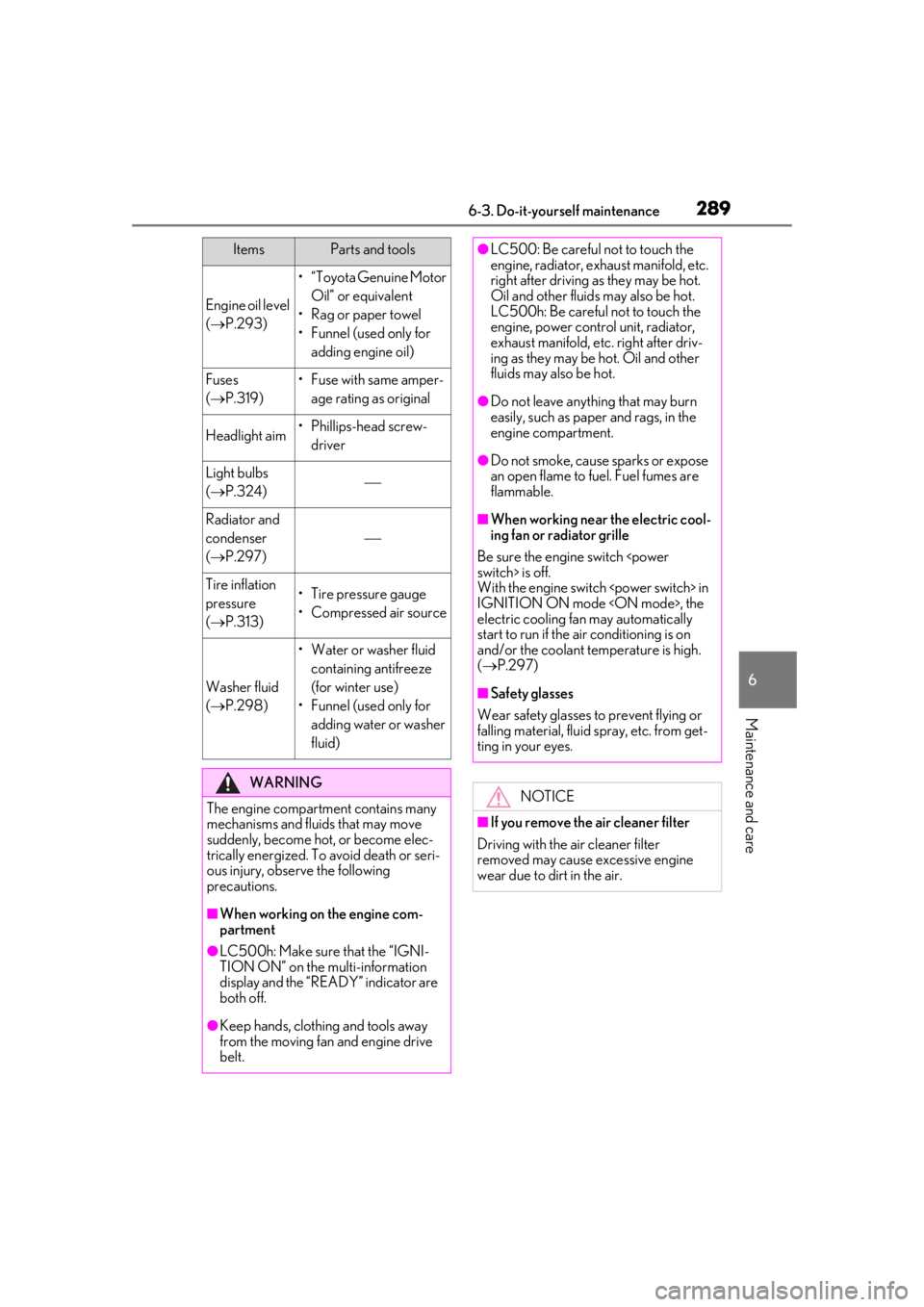
2896-3. Do-it-yourself maintenance
6
Maintenance and care
Engine oil level
( P.293)
• “Toyota Genuine Motor
Oil” or equivalent
• Rag or paper towel
• Funnel (used only for adding engine oil)
Fuses
( P.319)•Fuse with same amper-
age rating as original
Headlight aim• Phillips-head screw-driver
Light bulbs
( P.324)
Radiator and
condenser
( P.297)
Tire inflation
pressure
( P.313)• Tire pressure gauge
• Compressed air source
Washer fluid
( P.298)
• Water or washer fluid
containing antifreeze
(for winter use)
• Funnel (used only for adding water or washer
fluid)
WARNING
The engine compartment contains many
mechanisms and fluids that may move
suddenly, become hot, or become elec-
trically energized. To avoid death or seri-
ous injury, observe the following
precautions.
■When working on the engine com-
partment
●LC500h: Make sure that the “IGNI-
TION ON” on the multi-information
display and the “READY” indicator are
both off.
●Keep hands, clothi ng and tools away
from the moving fan and engine drive
belt.
ItemsParts and tools●LC500: Be careful not to touch the
engine, radiator, exhaust manifold, etc.
right after driving as they may be hot.
Oil and other fluids may also be hot.
LC500h: Be careful not to touch the
engine, power control unit, radiator,
exhaust manifold, etc. right after driv-
ing as they may be hot. Oil and other
fluids may also be hot.
●Do not leave anything that may burn
easily, such as paper and rags, in the
engine compartment.
●Do not smoke, cause sparks or expose
an open flame to fuel. Fuel fumes are
flammable.
■When working near the electric cool-
ing fan or radiator grille
Be sure the engine switch
With the engine switch
IGNITION ON mode
electric cooling fan may automatically
start to run if the air conditioning is on
and/or the coolant temperature is high.
( P.297)
■Safety glasses
Wear safety glasses to prevent flying or
falling material, fluid spray, etc. from get-
ting in your eyes.
NOTICE
■If you remove the air cleaner filter
Driving with the air cleaner filter
removed may cause excessive engine
wear due to dirt in the air.
Page 314 of 432
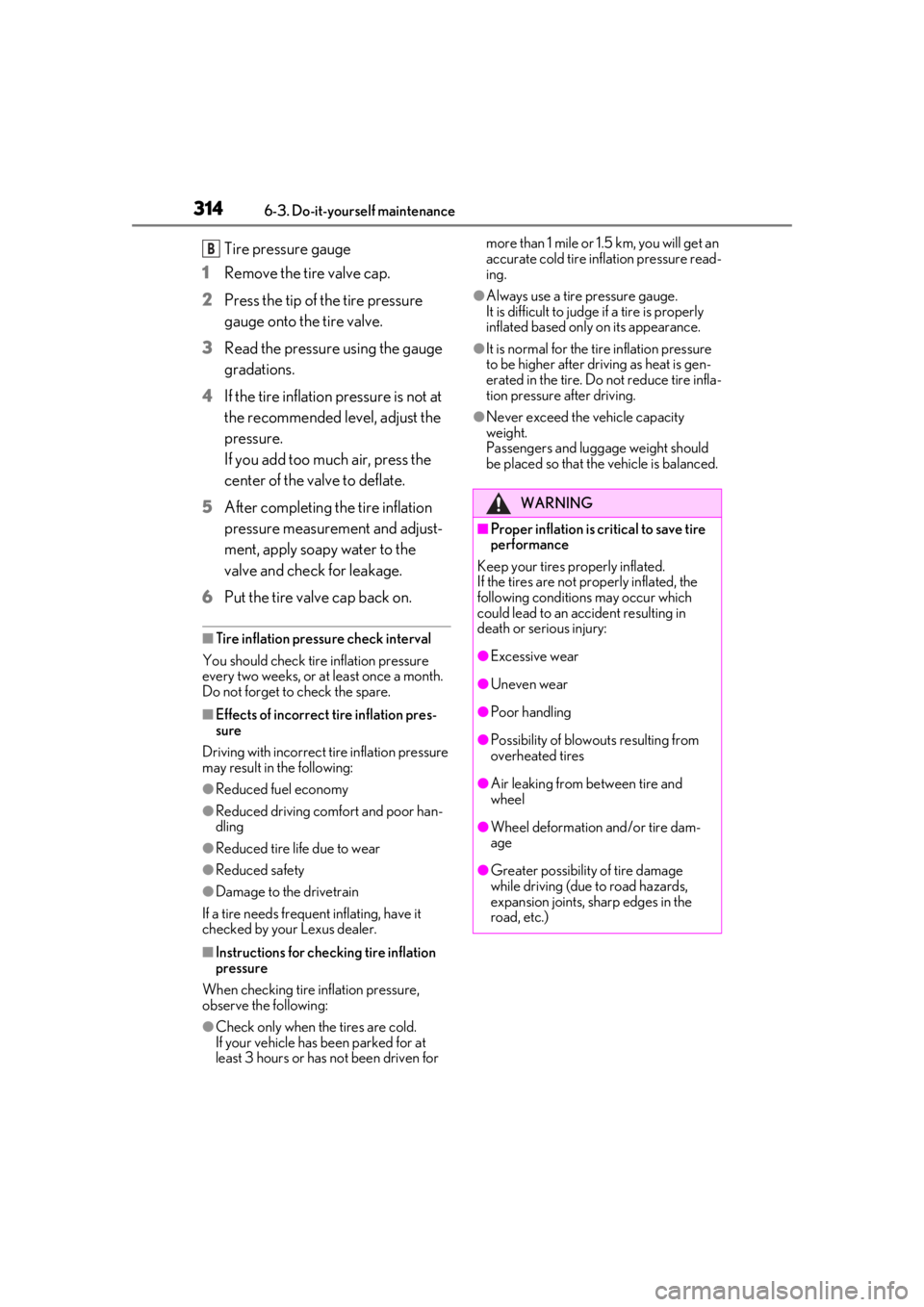
3146-3. Do-it-yourself maintenance
Tire pressure gauge
1 Remove the tire valve cap.
2 Press the tip of the tire pressure
gauge onto the tire valve.
3 Read the pressure using the gauge
gradations.
4 If the tire inflation pressure is not at
the recommended level, adjust the
pressure.
If you add too much air, press the
center of the valve to deflate.
5 After completing the tire inflation
pressure measurem ent and adjust-
ment, apply soapy water to the
valve and check for leakage.
6 Put the tire valve cap back on.
■Tire inflation pressure check interval
You should check tire inflation pressure
every two weeks, or at least once a month.
Do not forget to check the spare.
■Effects of incorrect tire inflation pres-
sure
Driving with incorrect ti re inflation pressure
may result in the following:
●Reduced fuel economy
●Reduced driving comfort and poor han-
dling
●Reduced tire life due to wear
●Reduced safety
●Damage to the drivetrain
If a tire needs frequent inflating, have it
checked by your Lexus dealer.
■Instructions for checking tire inflation
pressure
When checking tire inflation pressure,
observe the following:
●Check only when the tires are cold.
If your vehicle has been parked for at
least 3 hours or has not been driven for more than 1 mile or 1.5 km, you will get an
accurate cold tire inflation pressure read-
ing.
●Always use a tire pressure gauge.
It is difficult to judge if a tire is properly
inflated based only on its appearance.
●It is normal for the ti
re inflation pressure
to be higher after driving as heat is gen-
erated in the tire. Do not reduce tire infla-
tion pressure after driving.
●Never exceed the vehicle capacity
weight.
Passengers and luggage weight should
be placed so that the vehicle is balanced.
B
WARNING
■Proper inflation is critical to save tire
performance
Keep your tires properly inflated.
If the tires are not properly inflated, the
following conditions may occur which
could lead to an accident resulting in
death or serious injury:
●Excessive wear
●Uneven wear
●Poor handling
●Possibility of blowouts resulting from
overheated tires
●Air leaking from between tire and
wheel
●Wheel deformation and/or tire dam-
age
●Greater possibility of tire damage
while driving (due to road hazards,
expansion joints, sharp edges in the
road, etc.)
Page 325 of 432
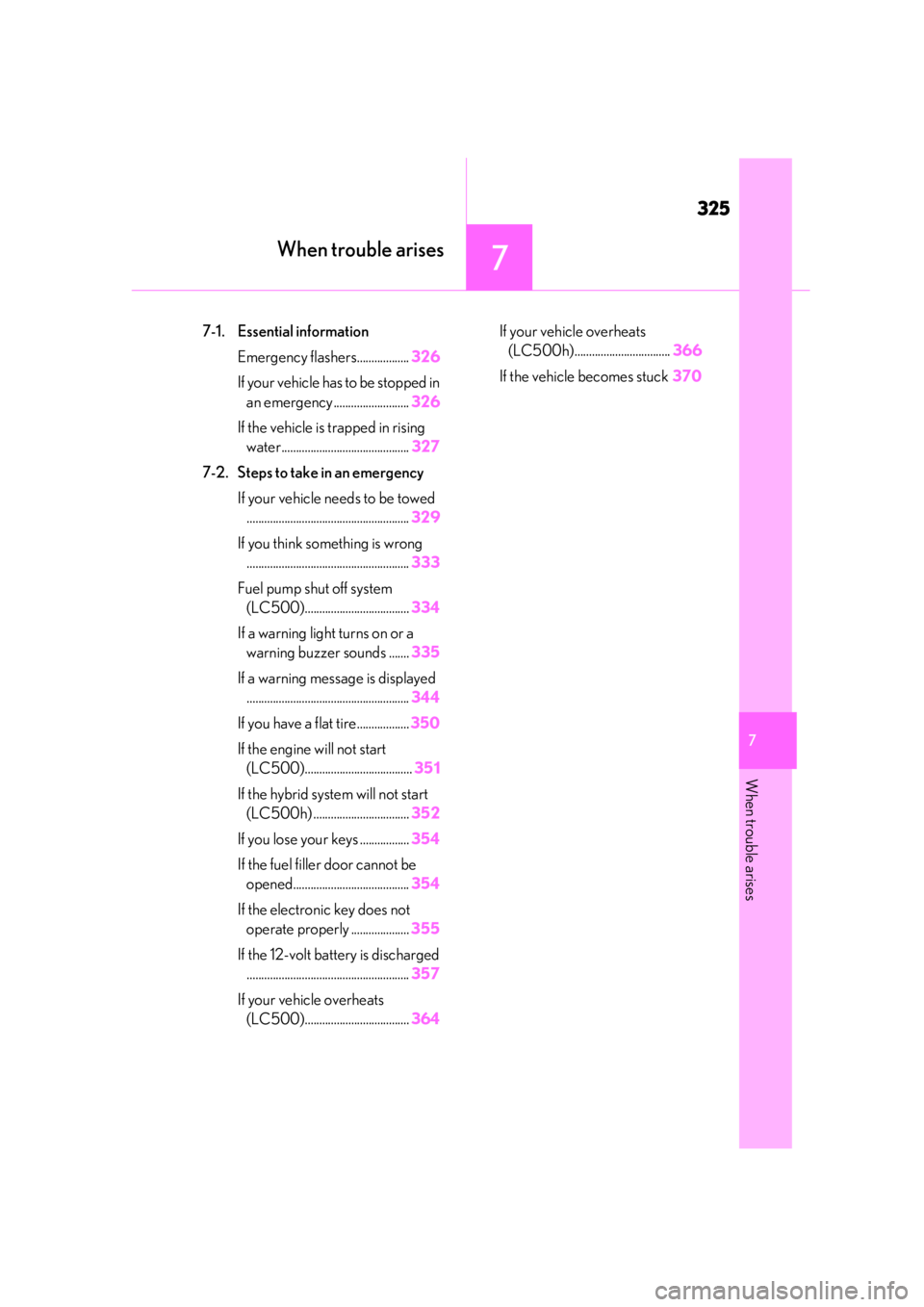
325
7
7
When trouble arises
When trouble arises
7-1. Essential informationEmergency flashers.................. 326
If your vehicle has to be stopped in an emergency .......................... 326
If the vehicle is trapped in rising water............................................ 327
7-2. Steps to take in an emergency If your vehicle needs to be towed........................................................ 329
If you think something is wrong ........................................................ 333
Fuel pump shut off system (LC500).................................... 334
If a warning light turns on or a warning buzzer sounds ....... 335
If a warning message is displayed ........................................................ 344
If you have a flat tire.................. 350
If the engine will not start (LC500)..................................... 351
If the hybrid system will not start (LC500h) ................................. 352
If you lose your keys ................. 354
If the fuel filler door cannot be opened........................................ 354
If the electronic key does not operate properly .................... 355
If the 12-volt battery is discharged ........................................................ 357
If your vehicle overheats (LC500).................................... 364If your vehicle overheats
(LC500h)................................. 366
If the vehicle becomes stuck 370
Page 334 of 432
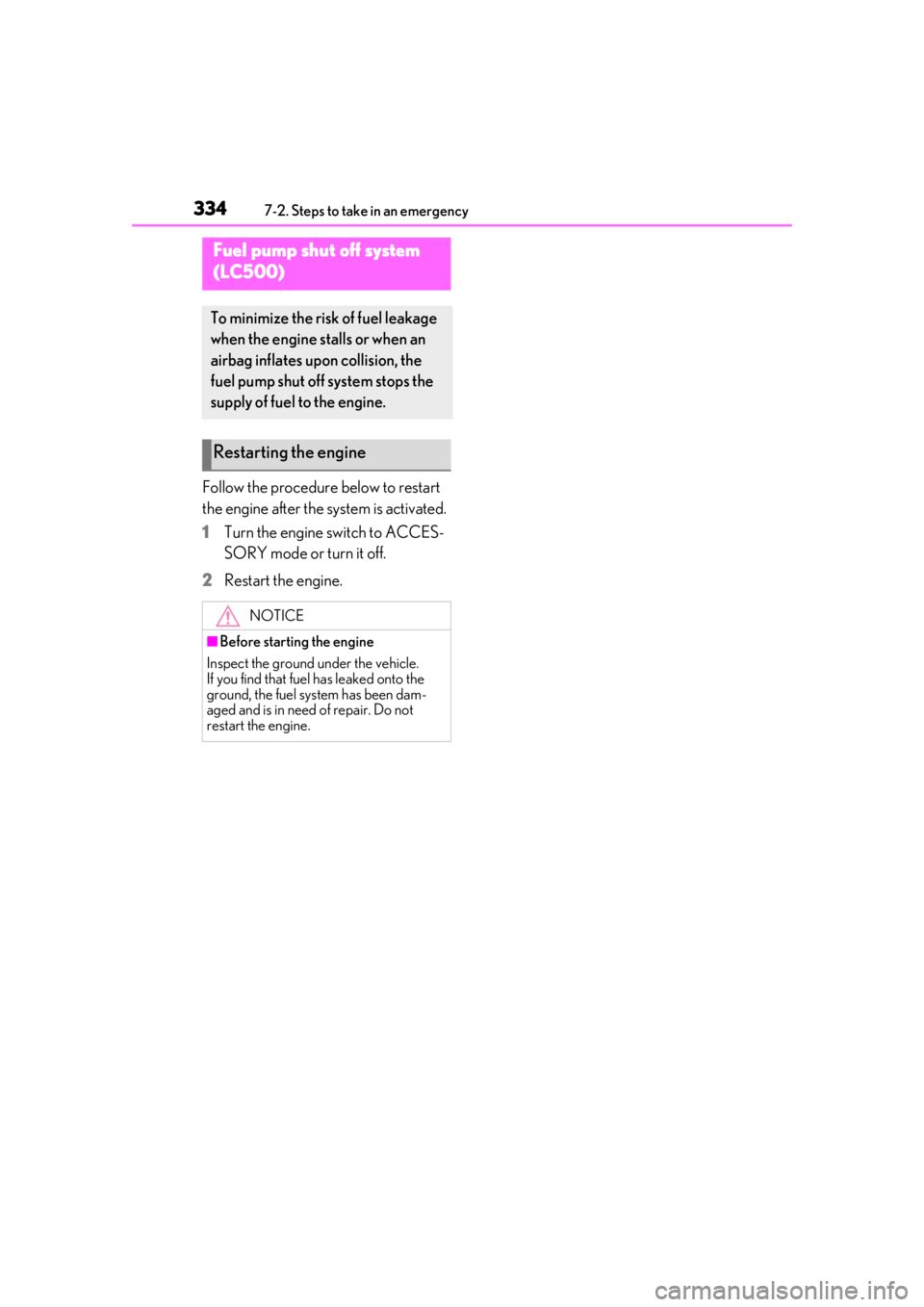
3347-2. Steps to take in an emergency
Follow the procedure below to restart
the engine after the system is activated.
1Turn the engine switch to ACCES-
SORY mode or turn it off.
2 Restart the engine.
Fuel pump shut off system
(LC500)
To minimize the risk of fuel leakage
when the engine stalls or when an
airbag inflates upon collision, the
fuel pump shut off system stops the
supply of fuel to the engine.
Restarting the engine
NOTICE
■Before starting the engine
Inspect the ground under the vehicle.
If you find that fuel has leaked onto the
ground, the fuel system has been dam-
aged and is in need of repair. Do not
restart the engine.
Page 339 of 432
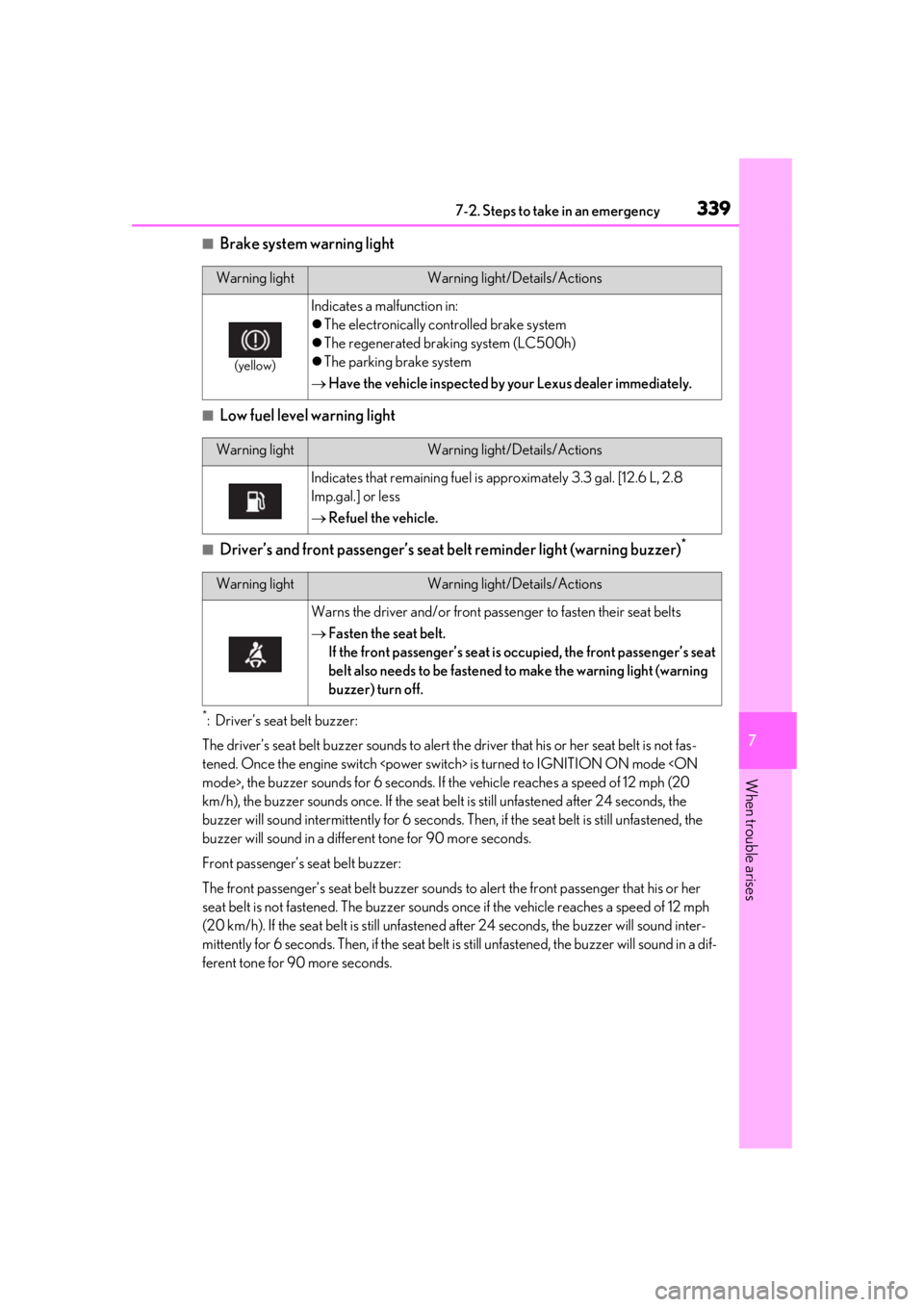
3397-2. Steps to take in an emergency
7
When trouble arises
■Brake system warning light
■Low fuel level warning light
■Driver’s and front passenger’s seat belt reminder light (warning buzzer)*
*: Driver’s seat belt buzzer:
The driver’s seat belt buzzer sounds to alert th e driver that his or her seat belt is not fas-
tened. Once the engine switch
km/h), the buzzer sounds once. If the seat belt is still unfastened afte r 24 seconds, the
buzzer will sound interm ittently for 6 seconds. Then, if the seat belt is still unfastened, the
buzzer will sound in a different tone for 90 more seconds.
Front passenger’s seat belt buzzer:
The front passenger’s seat belt buzzer sounds to alert the front passenger that his or her
seat belt is not fasten ed. The buzzer sounds once if the vehicle reaches a speed of 12 mph
(20 km/h). If the seat belt is still unfastened after 24 seconds, the buzzer will sound inter-
mittently for 6 seconds. Then, if the seat belt is still unfastened, the buzzer will sound in a dif-
ferent tone for 90 more seconds.
Warning lightWarning light/Details/Actions
(yellow)
Indicates a malfunction in:
The electronically controlled brake system
The regenerated braking system (LC500h)
The parking brake system
Have the vehicle inspected by your Lexus dealer immediately.
Warning lightWarning light/Details/Actions
Indicates that remaining fuel is approximately 3.3 gal. [12.6 L, 2.8
Imp.gal.] or less
Refuel the vehicle.
Warning lightWarning light/Details/Actions
Warns the driver and/or front passe nger to fasten their seat belts
Fasten the seat belt.
If the front passenger’s seat is occupied, the front passenger’s seat
belt also needs to be fastened to make the warning light (warning
buzzer) turn off.
Page 341 of 432
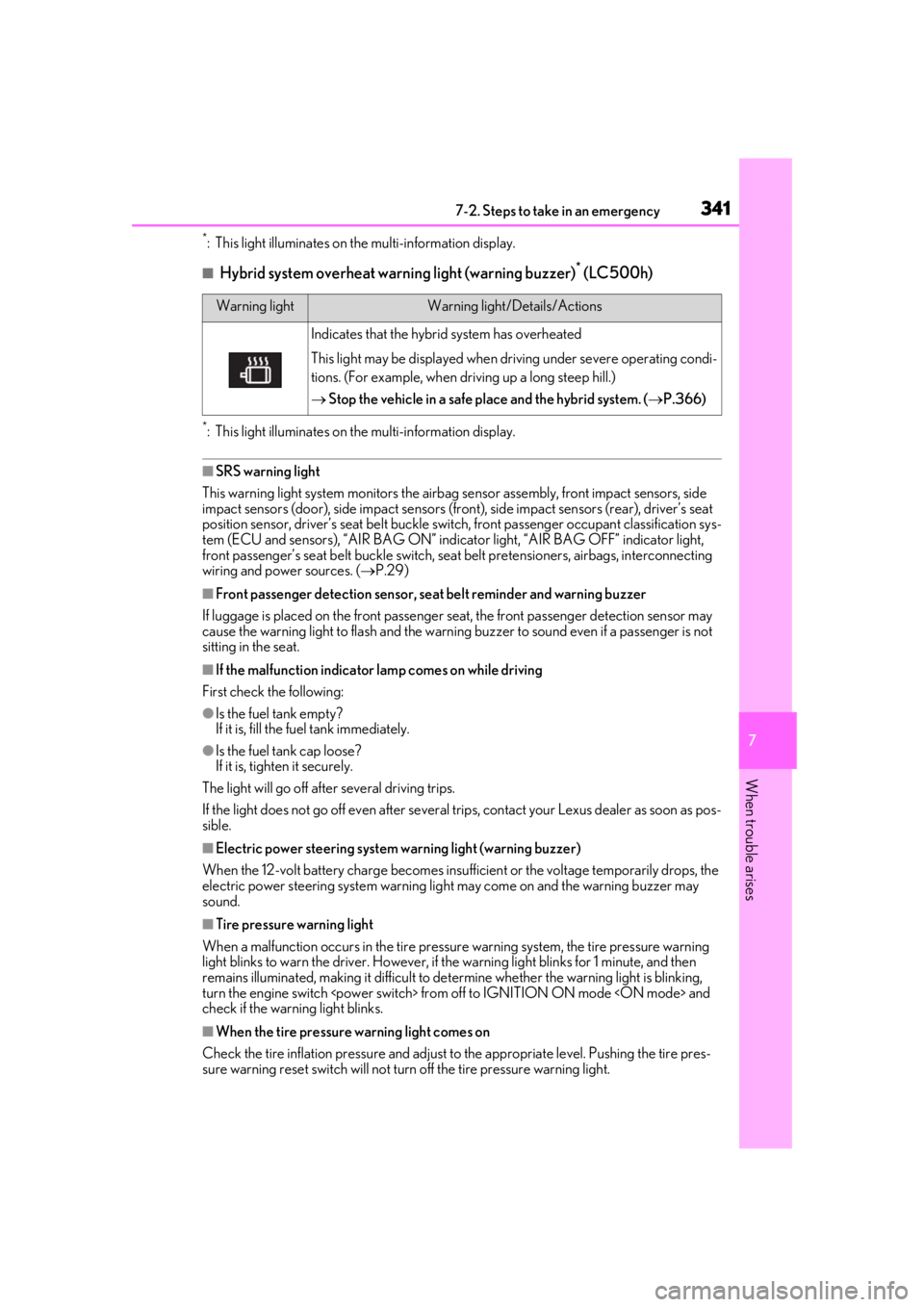
3417-2. Steps to take in an emergency
7
When trouble arises
*: This light illuminates on the multi-information display.
■Hybrid system overheat warning light (warning buzzer)* (LC500h)
*: This light illuminates on the multi-information display.
■SRS warning light
This warning light system monitors the airbag sensor assembly, front impact sensors, side
impact sensors (door), side impa ct sensors (front), side impact sensors (rear), driver’s seat
position sensor, driver’s seat belt buckle switch, front passeng er occupant classification sys-
tem (ECU and sensors), “AIR BAG ON” indicat or light, “AIR BAG OFF” indicator light,
front passenger’s seat be lt buckle switch, seat belt preten sioners, airbags, interconnecting
wiring and power sources. ( P.29)
■Front passenger detection sensor, seat belt reminder and warning buzzer
If luggage is placed on the front passenger seat, the front passenger detection sensor may
cause the warning light to flash and the warning buzzer to sound even if a passenger is not
sitting in the seat.
■If the malfunction indicator lamp comes on while driving
First check the following:
●Is the fuel tank empty?
If it is, fill the fuel tank immediately.
●Is the fuel tank cap loose?
If it is, tighten it securely.
The light will go off af ter several driving trips.
If the light does not go off even after several trips, contact your Lexus dealer as soon as pos-
sible.
■Electric power steering system warning light (warning buzzer)
When the 12-volt battery charge becomes insufficient or the voltage temporarily drops, the
electric power steering syst em warning light may come on and the warning buzzer may
sound.
■Tire pressure warning light
When a malfunction occurs in the tire pressure warning system, the tire pressure warning
light blinks to warn the driver . However, if the warning light blinks for 1 minute, and then
remains illuminated, making it difficult to determine whether the warning light is blinking,
turn the engine switch
check if the warning light blinks.
■When the tire pressure warning light comes on
Check the tire inflation pressure and adjust to the appropriate level. Pushing the tire pres-
sure warning reset switch will not turn off the tire pressure warning light.
Warning lightWarning light/Details/Actions
Indicates that the hybrid system has overheated
This light may be displayed when driving under severe operating condi-
tions. (For example, when driving up a long steep hill.)
Stop the vehicle in a safe place and the hybrid system. ( P.366)
Page 343 of 432
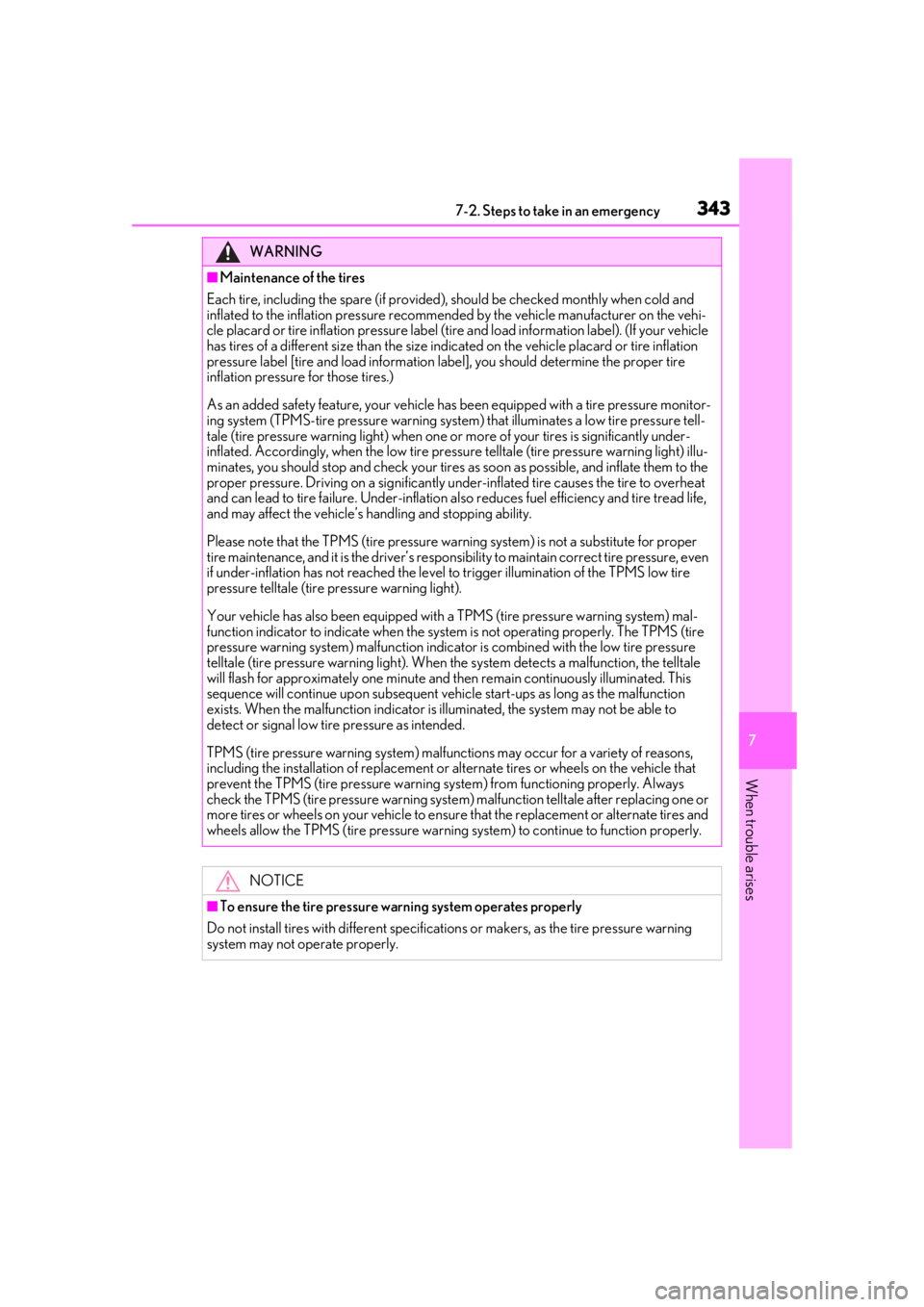
3437-2. Steps to take in an emergency
7
When trouble arises
WARNING
■Maintenance of the tires
Each tire, including the spare (if provided), should be checked monthly when cold and
inflated to the inflation pressure recommended by the vehicle manufacturer on the vehi-
cle placard or tire inflation pr essure label (tire and load info rmation label). (If your vehicle
has tires of a different size th an the size indicated on the vehicle placard or tire inflation
pressure label [tire and load information label], you should determine the proper tire
inflation pressure for those tires.)
As an added safety feature, your vehicle has been equipped with a tire pressure monitor-
ing system (TPMS-tire pressure warning system) that illuminates a low tire pressure tell-
tale (tire pressure warning light) when one or more of your tires is significantly under-
inflated. Accordingly, when the low tire pressu re telltale (tire pressure warning light) illu-
minates, you should stop and check your tires as soon as possible, and inflate them to the
proper pressure. Driving on a si gnificantly under-inflated tire causes the tire to overheat
and can lead to tire failure. Under-inflation al so reduces fuel efficiency and tire tread life,
and may affect the vehicle’s handling and stopping ability.
Please note that the TPMS (tire pressure warning system) is not a substitute for proper
tire maintenance, and it is the driver’s respon sibility to maintain correct tire pressure, even
if under-inflation has not reac hed the level to trigger illumina tion of the TPMS low tire
pressure telltale (tire pressure warning light).
Your vehicle has also been equipped with a TPMS (tire pressure warning system) mal-
function indicator to indicate when the system is not operating properly. The TPMS (tire
pressure warning system) malfunction indicator is combined with the low tire pressure
telltale (tire pressure warning light). When the system detect s a malfunction, the telltale
will flash for approximately one minute and th en remain continuously illuminated. This
sequence will continue upon subsequent vehi cle start-ups as long as the malfunction
exists. When the malfunction in dicator is illuminated, the system may not be able to
detect or signal low tire pressure as intended.
TPMS (tire pressure warning system) malfunctions may occur for a variety of reasons,
including the installation of re placement or alternate tires or wheels on the vehicle that
prevent the TPMS (tire pressure warning sy stem) from functioning properly. Always
check the TPMS (tire pressure warning system ) malfunction telltale after replacing one or
more tires or wheels on your vehicle to ensu re that the replacement or alternate tires and
wheels allow the TPMS (tire pr essure warning system) to cont inue to function properly.
NOTICE
■To ensure the tire pressure warning system operates properly
Do not install tires with differ ent specifications or makers, as the tire pressure warning
system may not operate properly.
Page 346 of 432

3467-2. Steps to take in an emergency
●Malfunction in the EPS (Electric Power Steering) system
The electric power steering sy stem warning light comes on. ( P.336)
●Malfunction in the tire pressure warning system
The tire pressure warn ing light comes on. ( P.340)
●Remaining fuel level is low
The low fuel level warning light comes on. ( P.339)
■If “Hybrid System Overheated Reduce d Output Power” is shown (LC500h)
This message may be displayed when driving under severe operating conditions. (For exam-
ple, when driving up a long steep hill.) Stop and check. ( P.366)
■If “Traction Battery Needs to be Protected Re frain from the Use of N Position” is shown
(LC500h)
This message may be displayed wh en the shift position is in N.
As the hybrid battery (traction battery) cannot be charged when the shift position is in N,
shift the shift position to P when the vehicle is stopped.
■If “Traction Battery needs to be Protected Shift into P to Restart” is shown (LC500h)
This message is displayed when the hybrid ba ttery (traction battery) charge has become
extremely low because the vehicle has been left with the N shift position selected for a cer-
tain amount of time.
When operating the vehicle, shift to P and restart the hybrid system.
■If “Shift to P Before Exiting Vehicle” is shown
The driver’s door is opened without turning the engine switch
shift lever in any position other than P. Shift the shift position to P.
■If “Shift Is in N Release Accelerator Before Shifting” is shown
The accelerator pedal has been depressed when th e shift position is in N. Release the accel-
erator pedal and shift the shift position to D or R.
■If “Depress Brake when Vehicle Is Stoppe d Hybrid System May Overheat” is shown
(LC500h)
The message may be displayed when the accelerator pedal is depressed to hold the vehicle
while the vehicle is stopped on an uphill etc. The hybrid system may overheat. Release the
accelerator pedal and de press the brake pedal.
■If “Shift system malfunction Driving unavailable” is shown
There is a malfunction in the shift control system. Have the vehicle inspected by your Lexus
dealer immediately.
■If “Auto Power Off to Conserve Battery” is shown
LC500:
Power was turned off due to the automatic power off function. Next time when starting the
engine, increase the engine speed slightly an d maintain that level for approximately 5 min-
utes to recharge the battery.
LC500h:
Power was turned off due to the automatic power off function. Next time when starting the
hybrid system, operate the hybrid system for approximately 5 minutes to recharge the 12-
volt battery.